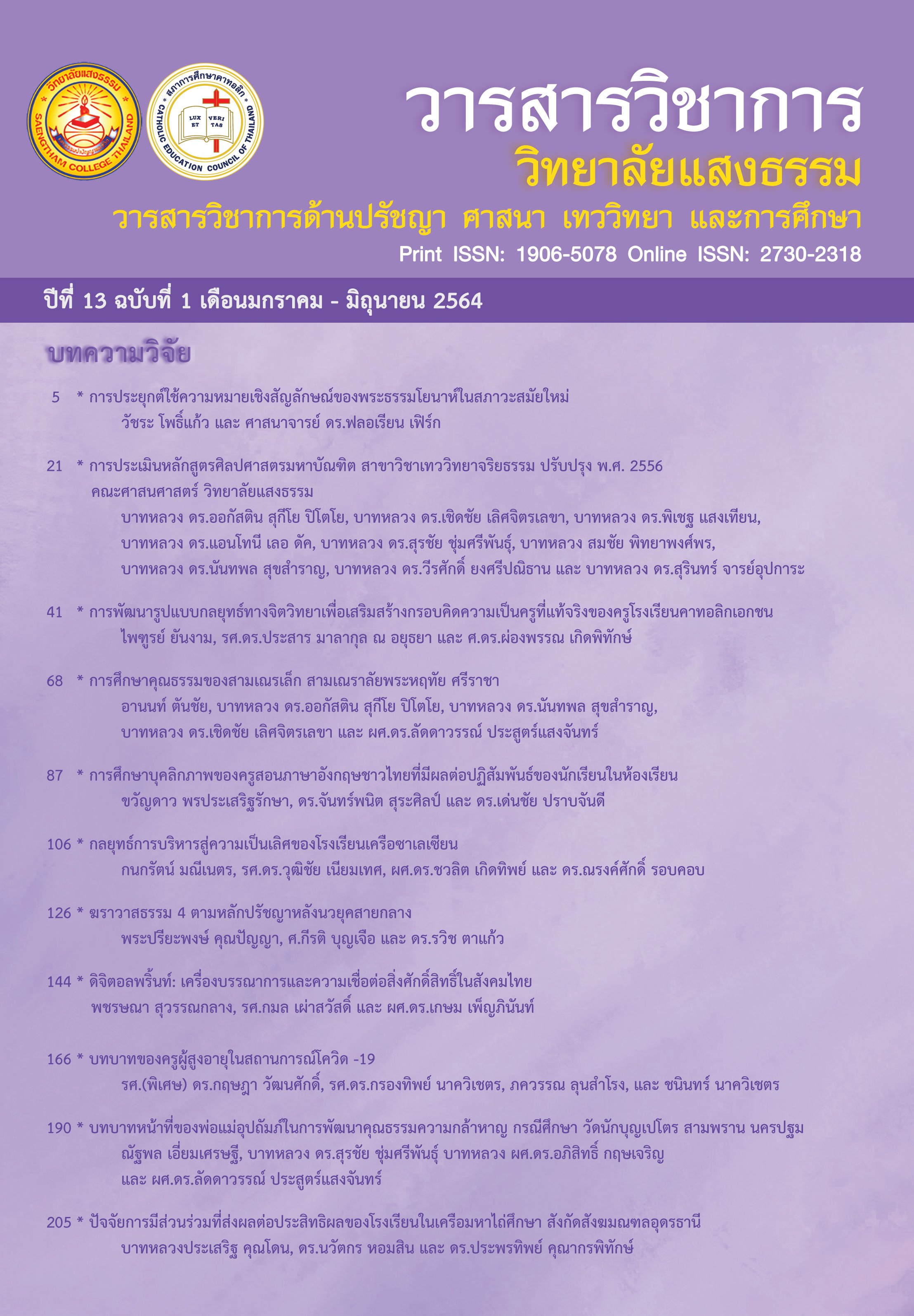Digital Print: Tribute and Beliefs of Sacred Beings in Thai Society.
Main Article Content
Abstract
The current research aims to create a digital work of art from votive offerings, which reflects the fundamental basis of the superstitious beliefs of Thai people since ancient times. Such beliefs brought about giving votive offerings to Hindu deities among city dwellers in Ratchaprasong area, Bangkok. The result revealed that the superstitious objects based on cultural and regional beliefs were associated with the concepts of Hindu theology, which consisted of specific prayers, sacred animal symbols and tributes related to the concept and perceived power of animism. Furthermore, there existed rituals regarding worshipping gods, yearning and praying for their wishes to be fulfilled in exchange for certain tributes. The aforementioned concepts were presented through Bhakti yoga that illustrated passion and reverence through Buja to gods as though they actually existed. The research study adopted a qualitative method by the use of a field survey as well as references in order to review literature, theories, previous research studies, and related works of art, which were all analyzed and synthesized into fantastic art. The work of art indicated contemporary local beliefs of the votive offerings. The image was based on legends, manuscripts, the belief of the Three Worlds, and folklore. Superstitious beliefs and experiences were given meanings, which integrated imaginative supernatural beliefs with demonstrated human beliefs and rituals comparable to language and communication between gods and humans. It intended to impart goodness in the human mind as well as the ancient supernatural belief in the votive offerings translated into the contemporary version of such ritual.
Article Details
- The articles have been published in academic Saengtham College Journal Is owned by Saengtham College Do not republish all text. Except permission from Saengtham College.
- Any content and comments Published in academic Saengtham College Journal. It is the responsibility of the author only.
References
กิตติ วัฒนะมหาตม์. (2561). เทวกำเนิด. [ออนไลน์]. เข้าถึงได้จาก : https://www.siamganesh.com/devaborn.html. วันที่ค้นข้อมูล : 8 สิงหาคม 2561.
งามพิศ สัตย์สงวน. (2545). การหน้าที่ที่กำลังเปลี่ยนแปลงของสถาบันศาสนาใน: กรณีศึกษาศาสนาพุทธ (วัดไตรมิตร). กรุงเทพฯ: ภาควิชาสังคมวิทยาและมานุษยวิทยา คณะรัฐศาสตร์ จุฬาฯ.
ชูเรียน, วอลเตอร์. (2552). ศิลปะแฟนตาสติก = Fantastic art. กรุงเทพฯ: เดอะเกรทไฟน์อาร์ท.
เดย์ ฟรีแมน, ธนา ลิมปยารยะ และ พระมหาราชครูพิธีศรีวิสุทธิคุณ. (2558). The Chair เก้าอี้มีเรื่อง ตอนพระพิฆเนศ. [ออนไลน์]. เข้าถึงได้จาก : https://www.youtube.com/watch?v=JG4-0_IF6kM. วันที่ค้นข้อมูล : 20 สิงหาคม 2561.
ธวัชชัย สมคง. (2547). บทความพิเศษ ถวัลย์ ดัชนี. [ออนไลน์]. เข้าถึงได้จาก : http://www.fineart-magazine.com/ถวัลย์-ดัชนี. วันที่ค้นข้อมูล: 15 กันยายน 2561.
นิธิ เอียวศรีวงศ์. (2546). ลัทธิพิธีเสด็จพ่อ ร.5. กรุงเทพฯ: บริษัทมิติชน จำกัด (มหาชน).
ณัฐ ล้ำเลิศ. (2557). จิตรกรรมค่าต่างแสงกับความรู้สึกสงบแบบเหนือจริง เนื้อหาวัตถุในพิธีกรรมพุทธศาสนา. [ออนไลน์]. เข้าถึงได้จาก : http://www.journal.rmutt.ac.th:8080/index.php/arts/article/view/294. วันที่ค้นข้อมูล : 17 กันยายน 2561.
ปรีชา ช้างขวัญยืน และสมภาร พรมทา. (2556). มนุษย์กับศาสนา. กรุงเทพฯ: โครงการเผยแพร่ผลงานวิชาการ คณะอักษรศาสตร์ จุฬาลงกรณ์มหาวิทยาลัย.
พวงเพชร สุรัตนกวีกุล และเฌอมาลย์ ราชภัฎฑารักษ์, บรรณาธิการ. (2542). มนุษย์กับสังคม. กรุงเทพฯ: สำนักพิมพ์มหาวิทยาลัยเกษตรศาสตร์.
พีรพล อิศรภักดี. (2561). พัฒนาการของศาสนาฮินดู. [ออนไลน์]. เข้าถึงได้จาก : https://www.siamganesh.com/sixvisions.html. วันที่ค้นข้อมูล : 22 กันยายน 2561.
พระมหาราชครูพิธีศรีวิสุทธิคุณ. (2557). จดหมายเหตุการณ์บูรณปฏิสังขรณ์เทวสถาน สำหรับพระนคร. กรุงเทพฯ: อัมรินทร์พริ้นติ้งแอนด์พับลิชชิ่ง.
ภัททิยา ยิมเรวัต. (2540, มกราคม-มิถุนายน). การเปลี่ยนแปลงวัฒนธรรมด้านความเชื่อและขนบธรรมเนียม ประเพณี. วารสารภาษาและวัฒนธรรม, 16(1), หน้า 5-12.
ยศ สันตสมบัติ. (2533). อำนาจ บุคลิกภาพและผู้นำการเมืองไทย. กรุงเทพฯ: สถาบันไทยคดีศึกษา มหาวิทยาลัยธรรมศาสตร์.
เลยาร์ด ริชาร์ด. (2550). ความสุข: หลากหลายข้อค้นพบของศาสตร์ใหม่แห่งความสุข = Happiness: lessons from a new science. กรุงเทพฯ: สวนเงินมีมา.
เศรษฐมันตร์ กาญจนกุล. (2550). พระพิฆเนศ: มหาเทพแห่งความสำเร็จ. กรุงเทพฯ: เศรษฐศิลป์.
สุจิตต์ วงษ์เทศ. (2561). สุจิตต์ วงษ์เทศ: เข้าทรง และไหว้ครู มาจากพิธีเลี้ยงผี หลายพันปีมาแล้ว. [ออนไลน์]. เข้าถึงได้จาก : https://www.matichon.co.th/prachachuen/pracha-chuen-scoop/news_1030595. วันที่ค้นข้อมูล: 28 กันยายน 2561.
สุวรรณา สถาอานันท์ และ เนื่องน้อย บุณยเนตร. (2535). คำ: ร่องรอยความคิด ความเชื่อไทย. กรุงเทพฯ: สำนักพิมพ์แห่งจุฬาลงกรณ์มหาวิทยาลัย.
สุพจน์ สิงห์สาย .(2557). บัวบูชาพระรัตนตรัย. [ออนไลน์]. เข้าถึงได้จาก : http://decdna.su.ac.th/wp- content/uploads/2014/10/viscom-01.jpg. วันที่ค้นข้อมูล : 29 พฤษภาคม 2560.
เสฐียรโกเศศ, พระยา. (2515). เมืองสวรรค์และผีสางเทวดา. พระนคร: บรรณาคาร.
อนุมานราชธน, พระยา. (2484). วิจารณ์เรื่องประเพณีการทำศพ. พระนคร: ศรีหงส์.
อนุมานราชธน, พระยา. (2495). เรื่องผีสางเทวดา. พระนคร: โรงพิมพ์พระจันทร์.
อานันท์ กาญจนพันธุ์. (2555). เจ้าที่และผีปู่ย่าพลวัตของความรู้ชาวบ้านอำนาจและตัวตนของคนท้องถิ่น. กรุงเทพฯ: ภาควิชาสังคมวิทยาและมานุษยาวิทยา คณะสังคมศาสตร์ มหาวิทยาลัยเชียงใหม่.
อิทธิพล ตั้งโฉลก. (2554). บทวิเคราะห์ผลงานจิตรกรรมของนาย “อิทธิพล โดย ผศ. อิทธิพล”. [ออนไลน์]. เข้าถึงได้จาก : http://www.thaicritic.com/?p=136. วันที่ค้นข้อมูล: 15 ตุลาคม 2561.
ฮิลล์, นโปเลียน. (2557). ปรัชญาชีวิตศาสตร์แห่งความสำเร็จ = The Napoleon Hill's laws of success. กรุงเทพฯ: เดอะเกรทไฟน์อาร์ท.
Augustine, S. (1950). The greatness of the soul: The teacher (No. 9). Paulist Press.
Eco, U. (1986). Art and beauty in the middle ages. London: Yale University Press.
Klausner, W.J., (1963). “Popular Buddhism in North East Thailand”. in Epistemology in Anthropology. New York: Harper and Row.


